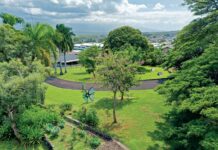Story by Paul Wood | Photography by Bob Bangerter
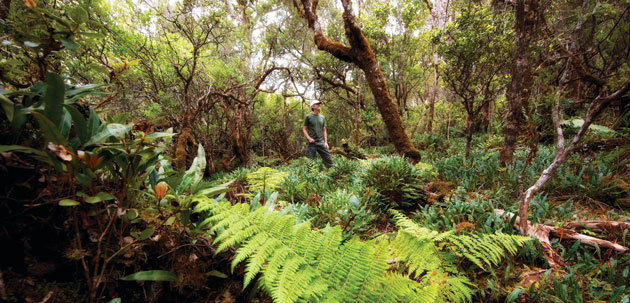 We drive up the mountain in silvery morning light, clouds shifting against the slopes above and below us. As we rise through the high pastures, Pat Bily points out fencing on Haleakala Ranch land, installed by the ranch to help protect the old forest above. As invasive-plant specialist for The Nature Conservancy’s Maui office, Pat has spent the past two decades-plus working inside that forest. He loves the fence.
We drive up the mountain in silvery morning light, clouds shifting against the slopes above and below us. As we rise through the high pastures, Pat Bily points out fencing on Haleakala Ranch land, installed by the ranch to help protect the old forest above. As invasive-plant specialist for The Nature Conservancy’s Maui office, Pat has spent the past two decades-plus working inside that forest. He loves the fence.
“When I first started, people had visions of fencing across the entire watershed,” he says. “I was thinking, ‘Oh right.’ But now it’s happened. That is historic.”
We’re headed to where the Conservancy’s efforts began on Maui thirty years ago. That’s when Haleakala Ranch granted the international organization the rights to work its conservation practices in what is now called Waikamoi Preserve, a 5,230-acre swath of mostly old-growth forest that runs from the Haleakala National Park boundary at 8,000 feet to the cloud-belt level of 4,400 feet.
We enter the preserve at the top, through a gate next to the Hosmer Grove campground, and scramble out of the truck into an artificial forest—Mexican weeping pines and cedars from all parts of the globe, a well-meant reforestation effort from the early twentieth century that filled in old pastureland. Typical of a conifer forest, the shadowy dirt under the thick trees is mostly bare of understory—low-growing plants. Rains have scoured away topsoil, leaving tree roots ribbed, nary a fern or flower. Pat says, “When we first started, 60 percent of the forest surface looked like this.”
Then he points to some ‘ohi‘a trees towering among the introduced cone-bearers. ‘Ohi‘a is the quintessential endemic Hawaiian plant, a tough slow grower that in Waikamoi forms massive brown columns rising above all competitors, then bursting into a dark canopy heaped with bristling clouds of scarlet flowers. Botanists have recently discovered, says Pat, that ‘ohi‘a trees of this size and girth are probably 1,500 years old. “If so, these are some of the oldest flowering plants on Earth.”
We hike along the side of a deep swale loaded with young native plants, koa seedlings, small flowering mamane trees, ‘ohi‘a both large and small. The gulch resonates with birdsong. “This gulch used to be full of those Mexican pines,” says Mark White, the Conservancy’s director of Maui programs. “Volunteer high school groups helped us pull out the pines, and the natives returned to take it over.”
The Nature Conservancy was well into its conservation efforts in Waikamoi when it decided to shift strategies. Instead of fighting for one narrow swath of forest, or working to save a particular endangered species, the organization started to think in terms of the entire high-mountain ecosystem. With fewer than a dozen staff members in the Maui office, and limited financial resources, the organization started looking for partners. In 1991, the Conservancy established a partnership with the East Maui Irrigation Company, Haleakala and Hana Ranches, the national park, the county’s Department of Water Supply, the state’s Department of Land & Natural Resources . . . all the major landowners on windward Haleakala.
An unprecedented collaboration of government, conservationists and private business, the East Maui Watershed Partnership became the prototype that has inspired similar action throughout Hawai‘i. Today ten such partnerships, representing more than sixty public and private partners, protect more than 1.5 million acres throughout the Islands—including roughly 150,000 acres on Maui that are habitat for some 530 species of endemic Hawaiian plants and at least twelve species of native birds that are the rarest in the world.
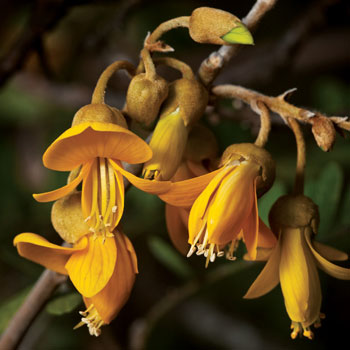
The East Maui Watershed Partnership recently finished fencing off 12,000 acres of native woodland and booting out marauders such as pigs and goats. Studies done in the past couple years are showing a threefold increase in native shrub cover and stability in the forest’s population of such endangered endemic birds as the Maui parrotbill and the crested honeycreeper (or ‘akohekohe). “We were super-excited to get that news,” says Mark. “The ecosystem has begun to heal itself. We don’t even know what the mountain is going to look like as it fully recovers.”
As we walk, Mark and Pat name the native birds as they hear them. The ‘i‘iwi sounds a lot like R2D2. The ‘apapane, flickering among the treetops, chats excitedly, the way a radio sounds when you cruise around the dial. Our guides talk about the water-holding efficiency of the native trees, as opposed to introduced species that drink too much and fail to engender the rainy mists so celebrated in the ancient chants. But I can tell that they are mostly fond of the honeycreepers. They know them all by their songs, which one is coming closer, which one is bickering.
We descend into the unspoiled forest on a footstep-wide trail as the canopy folds over us. The transition is vivid. Before, it was all upright cedars with their resinous smell, hard bare dirt below, some trailside weeds, bunch grasses, even some bristly gorse (the botanical equivalent of cancer) that Pat and crew have carefully poisoned. But now it becomes all softness and shadow and quiet as the limbs fold over us, not hogging the sun but sharing it level upon level under a blue sky that we can see streaming with filmy, racing clouds. There is no weed to be seen, no ground at all. Nothing but hosts of fern and moss and lichen.
A fallen tree limb becomes a grotto roofed with rank upon rank of upright tongue ferns. The gemlike peperomia plants, of the pepper family, which like to sprawl across the native forest floor, soon are thriving on any surface. The understory of the Hawaiian forest is a thick community of water—not of rain falling but of water sieved from the sky and held in the land and shared in a living meditation, a kind of satori of mist. Run your fingers into the foot-thick richness of moss, then remember the bare clay of the faux forest above, and you will understand the word “watershed.”
We hike down to a boardwalk the Conservancy has constructed of redwood planks. The boardwalk allows us to walk without damaging the humid tumult of the forest floor. The walk is only one-quarter mile, but we take more than an hour to travel it, stopping to gawk into the towering ‘ohi‘as and peering for glimpses into the flickering habits of endangered birds. It’s hard for me to pick out specifics in the raucous bebop overhead, not the way Mark and Pat can do it, knowing which birds are adolescents, which are bullies.
Hearing a crested honeycreeper, Mark shoves me his binoculars. I glimpse a raucous silhouette with a rockabilly hairdo, then it’s gone. Mark bangs me gleefully on the back. “Congratulations. There are about 3,000 individuals left on the planet, and they are all right here.” Thirty years ago they were headed for certain extinction. Today the population is stable, probably growing.
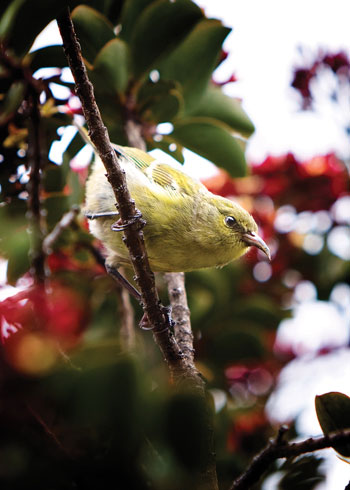
At the same time it was building partnerships to protect whole ecosystems, The Nature Conservancy was targeting the specific problem of very aggressive forest weeds, particularly several species of the melastome family, including miconia. To that end, the Conservancy helped found the Melastome Action Committee, which in 1997 evolved into the Maui Invasive Species Committee, or MISC. Their work has inspired “ISCs” on other islands. On Maui alone, during the first quarter of 2010, MISC workers inventoried more than 21,600 acres and eliminated close to 34,000 noxious plant pests. Now The Nature Conservancy is adopting a mountain-to-sea mission and employing new technologies such as GPS tracking and high-definition aerial photography. At age thirty, this organization has tremendous momentum.
At the bottom of our hike, as we share lunches, Mark says, “Isn’t this heaven? This is our return on investment.” He has the same enthusiasm I’ve seem in men who fan out pictures of their grandkids. But I realize what a poignant different there is between one’s progeny and the fate of a forest. As Pat Bily has said a couple times on this hike, “Recovery takes place in ecological time, not in human time.”
We talk a bit about the economic climate, the state now shriveling under wearisome talk of recession. Mark says, “We’ve had to cut our budget by 20 percent two years in a row. To tell you the truth, I’m really worried. This is by far the worst economic climate of my twenty-two years with the organization. If we don’t keep up the momentum, then the investment will be negated. It costs hundreds of times more to restore a forest than to preserve it.”
Saving the watershed will always be an uphill battle. But when you love the mountain forests, you naturally spend a lot of time trudging uphill.
Up is a heavenly direction.
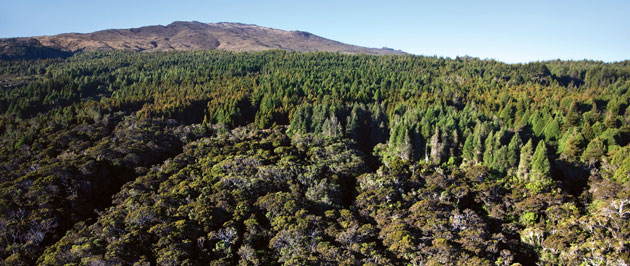
Why Watersheds Matter
In the Hawaiian Islands, every time we bathe, water our plants, or turn on the kitchen tap, we ought to look up at the nearest mountain and say, “Thank you.” Up there is what people call the watershed—miles of forests that rake water out of the sky, then hold that water in a great earthy sponge made of roots and humus and topsoil. From that sponge ooze our freshwater streams, which are our life.
No watershed, no water.
Half of the mountain’s original watershed is gone, shaved into pasturelands, plowed by pigs, and chewed up by hoofed creatures. Its plants have lost many of their pollinators—the curve-beaked honeycreeper birds that evolved along with the forest but have since succumbed to rats and to mosquito-borne avian malaria.
“Oh no!” one might think. “What if Maui becomes a deforested desert?”’ That’s what happened to Rapa Nui (Easter Island), where an advanced culture vanished after reducing the place to a desiccated grassland incapable of supporting human life. “If only someone had taken action to curtail this destruction!”
In fact, people have been working on behalf of the watershed for the past thirty years—The Nature Conservancy of Hawai‘i, with support from federal and state governments, landowners, and (perhaps) you. Thanks to the instigation and dedication of TNC, 1.5 million acres of Hawaiian watershed are now protected. This work began on Maui, at Waikamoi Preserve. Unlike so many environmental stories today, Waikamoi invites (cautious) optimism.
Get Involved
- Experience the Waikamoi Preserve for yourself on one of the National Park Service’s regular hikes. The Bird Loop Trail hike goes Monday and Thursday mornings at 8:45. The Boardwalk Trail hike goes on the third Sunday of the month at 1:45. Make reservations (required) by calling (808) 572-4459 between 8 a.m. and 4 p.m. Educational group excursions are arranged through the East Maui Watershed Partnership at 573-6999 (www.eastmauiwatershed.org).
- Join The Nature Conservancy (www.nature.org).
- Give to the Conservancy’s fundraising efforts. Call the director of philanthropy at (808) 587-6249.
- Communicate with your elected representatives. Let them know that proper management of Hawai‘i’s resources is top priority for you and the generations to come.




